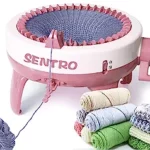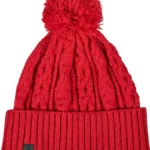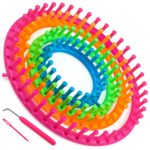Changing colors in knitting opens up a world of creative possibilities, allowing you to add depth, texture, and visual interest to your projects. Whether you're a seasoned knitter or just starting your knitting journey, learning how to switch colors is an essential skill that can transform your creations. In this article, we'll guide you through the step-by-step process of changing colors in knitting and explore different techniques to create stunning colorwork designs.
Choosing Yarn Colors
The first step in changing colors is selecting the right yarn colors for your project. Consider whether you want contrasting colors for bold patterns or complementary shades for a harmonious look. Experiment with color gradients or ombre effects to create striking visual transitions. Your choice of colors will influence the overall impact of your knitting project, so take some time to explore different color combinations and find what speaks to you.
Preparing for Color Changes
Before diving into color changes, it's crucial to prepare your work. If you're switching to a new color, make sure to secure the yarn tail from the previous color. This can be done by knitting a few stitches with both yarns held together or by weaving in the tail later. Position the new yarn on the side where the color change will occur for a seamless transition. Taking these steps ensures that your color changes are neat and tidy.
Joining the New Yarn
To join a new yarn color, you have several options depending on the pattern and desired finish. The most common method is overlapping the old and new yarns for a secure join. To do this, simply knit a few stitches with both yarns held together, making sure to keep the tension even. Alternatively, you can use the Russian join technique or the felted join for smaller color changes, eliminating the need to weave in yarn ends later.
Working with Multiple Colors
When you're working with multiple colors in the same row or round, you'll need to carry the unused yarn floats along the back of the work. This technique is commonly used in stranded knitting, also known as Fair Isle knitting. To avoid creating long floats, which can lead to snagging, it's essential to catch the floats every few stitches. This ensures a tidy and snag-free fabric, especially in projects like colorwork sweaters and accessories.
For more extensive color blocks in your design, intarsia knitting is an ideal technique. In intarsia, different colored yarns are used to create separate color blocks, and the yarn is carried along within the color block, eliminating the need for long floats. Intarsia is often used in creating bold, geometric patterns and pictorial designs.
Changing Colors in Simple Patterns
Changing colors in simple stitch patterns like garter stitch or stockinette stitch is relatively straightforward. In garter stitch, switch colors at the beginning of the row by knitting the first stitch with the new color. When changing colors in stockinette stitch, work the new color on the right side (knit) and purl on the wrong side, ensuring that the color change is smooth and invisible.
Changing Colors in Colorwork Patterns
Colorwork patterns involve creating intricate designs using different colored yarns. Stranded knitting, like Fair Isle, is a popular technique in colorwork, where multiple colors are used in the same row to create stunning patterns. When working with stranded knitting, it's essential to maintain an even tension, as tight knitting can cause puckering and loose knitting can create gaps between color changes.
Another colorwork technique is duplicate stitch, where you use a contrasting yarn to "duplicate" the stitches over an existing knitted fabric to add color details or embellishments. Duplicate stitch is excellent for adding small accents to your knitting project, like intricate motifs or initials.
Tips for Clean Color Changes
To ensure clean color changes in your knitting, pay attention to the following tips:
- Maintain even tension: Consistent tension is vital for an even fabric and seamless color transitions.
- Catch yarn floats: For stranded knitting, catch the yarn floats every few stitches to prevent snagging and maintain a smooth fabric.
- Use color charts: Color charts provide visual guidance for colorwork patterns, helping you keep track of color changes and design elements.
Finishing Color Changes
When you've completed your colorwork, it's time to finish the color changes. Weave in the yarn ends neatly and securely on the wrong side of the fabric, ensuring they are hidden from view. Blocking your finished project can also help even out the tension and enhance the colors, giving your knitting that professional touch.
Conclusion
Changing colors in knitting adds vibrancy and dimension to your projects, allowing you to unleash your creativity and create stunning designs. Whether you're using colorwork techniques like stranded knitting or simple color changes in basic stitch patterns, mastering this skill will elevate your knitting to a new level. So, grab your needles and yarn, pick your favorite colors, and embark on a colorful knitting adventure! Happy knitting!
To find out more about knitting, please visit any of the following areas:
- How to sew together knitting
- What is brioche knitting
- How to join yarn in knitting
- How to join in the round knitting
- How to finish a knitting scarf
- How to make a slip knot for knitting
- How to switch colors knitting
- How to hold yarn when knitting
- What does kfb mean in knitting
- How to fix a dropped stitch in knitting
- How to hold knitting needles
- What is frogging in knitting?
- How to change colors in knitting
- How to count rows in knitting
- How to increase in knitting
- How to slip stitch knitting
- How to yarn over in knitting
- What is a knitting loom?
- How to make bobbles in knitting?
- Where can I buy sentro knitting machine?
- What can you make with a sentro knitting machine?
- Cricut Hat Press: A Comprehensive Guide on Usage - August 13, 2023
- Unlocking Creativity with the Cricut Joy: A Comprehensive Guide - August 12, 2023
- The Ultimate Guide to the Cricut Maker Bundle - August 11, 2023





